Coda Technologies 16.0 Amplifier by Terry London

 In January of 2019, I did the first professional review of the Coda Technologies’ Continuum No. 8 amplifier and found it to be a stellar performer (reviewed here). I never doubted that the No. 8 amplifier’s build quality and engineering would be at a reference level, based on the history with Coda Technologies equipment. Still, I was quite impressed with its beautiful music presentation that competed with solid state-amplifiers that cost thousands of dollars more. For example, I had the Dan D’Agostino Progression Stereo amp (which retails for $15,500 more than the No. 8) in for review and the Coda amplifier outclassed it in tonality, transparency, speed, and soundstaging ability. I then went on to review Coda’s FET 07x preamplifier and put it on the list for Stereo Times “MOST WANTED COMPONENTS OF THE DECADE,” being the best performing solid-state preamplifier I had heard in over twenty years.
In January of 2019, I did the first professional review of the Coda Technologies’ Continuum No. 8 amplifier and found it to be a stellar performer (reviewed here). I never doubted that the No. 8 amplifier’s build quality and engineering would be at a reference level, based on the history with Coda Technologies equipment. Still, I was quite impressed with its beautiful music presentation that competed with solid state-amplifiers that cost thousands of dollars more. For example, I had the Dan D’Agostino Progression Stereo amp (which retails for $15,500 more than the No. 8) in for review and the Coda amplifier outclassed it in tonality, transparency, speed, and soundstaging ability. I then went on to review Coda’s FET 07x preamplifier and put it on the list for Stereo Times “MOST WANTED COMPONENTS OF THE DECADE,” being the best performing solid-state preamplifier I had heard in over twenty years.
Both above mentioned Coda pieces were based on the modifications and breakthroughs that Doug Dale, President & CEO and house engineer Eric Lauchli had made in what was the fourth generation of honing the circuit topology and internal parts of these designs. This led to the development of the subject of this review – the new 16.0 amplifier. The 16.0 is Coda’s flagship Class-A stereo amplifier. It retails for $13,000 without meters or $16,000 with meters, sharing the design of the company’s 41.0 amplifiers. The 41.0 can produce even more power than the 16.0. However, it does not drop as much pure Class-A (100 watts) as the 16.0. Optimized for Class-A operation, the 16.0 is better suited to low-impedance speaker systems where higher current capability yields superior performance. I asked Doug Dale some comments on what he discovered in designing the No.8 that lead to the design of the 16.0.
 “We were initially working on the N0. 8, which we introduced early in 2019, we had altered our amplifier gain stages around a newly available low noise FET transistor. We found that the new device provided a much lower noise floor than the prior generation FETs that were available. The response we have gotten has been consistent and very positive. We substituted that part into our preamps which also were similarly altered. Naturally, when we started the 16.0, we incorporated the same components in that circuit as well with the same result. As manufacturers, we constantly look for interesting components and since all of our designs use FET based input sections every product in our line has benefited. (As I shared in my review on the Coda FET 07x preamplifier FET transistors work and measure in a similar fashion like tubes offering the color and spatial qualities that tubes provide in a system.)
“We were initially working on the N0. 8, which we introduced early in 2019, we had altered our amplifier gain stages around a newly available low noise FET transistor. We found that the new device provided a much lower noise floor than the prior generation FETs that were available. The response we have gotten has been consistent and very positive. We substituted that part into our preamps which also were similarly altered. Naturally, when we started the 16.0, we incorporated the same components in that circuit as well with the same result. As manufacturers, we constantly look for interesting components and since all of our designs use FET based input sections every product in our line has benefited. (As I shared in my review on the Coda FET 07x preamplifier FET transistors work and measure in a similar fashion like tubes offering the color and spatial qualities that tubes provide in a system.)
In addition, the 16.0 amplifier has a 40% increase in power supply capacitance over the previous Model 15.5 to 280,000uf. Sonically, the lower noise and even larger power supply make the performance at lower power much more pleasant. It is subtle when necessary while having a huge reserve of power when needed. It is the best single chassis stereo amplifier we have ever produced. The 16.0 is also the most visually striking amplifier in the history of Coda.”
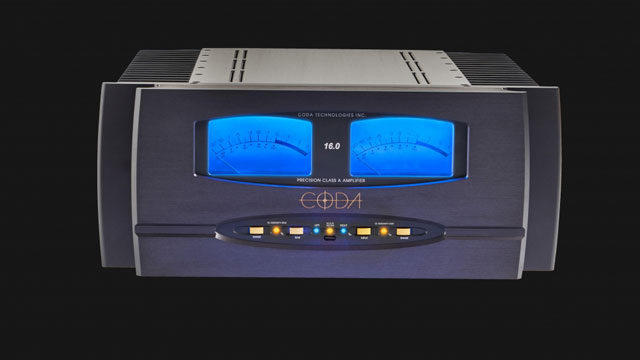
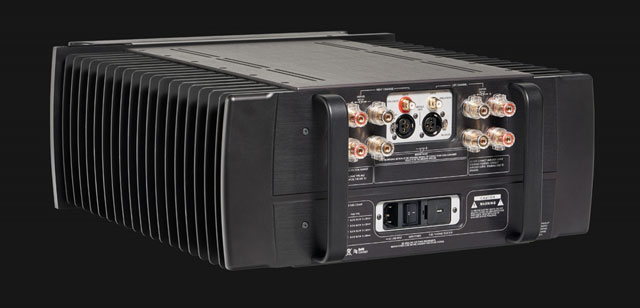
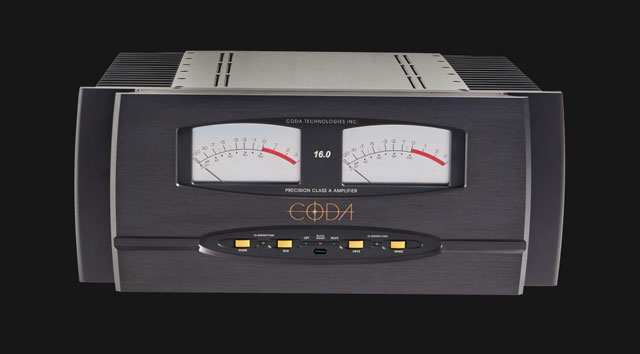
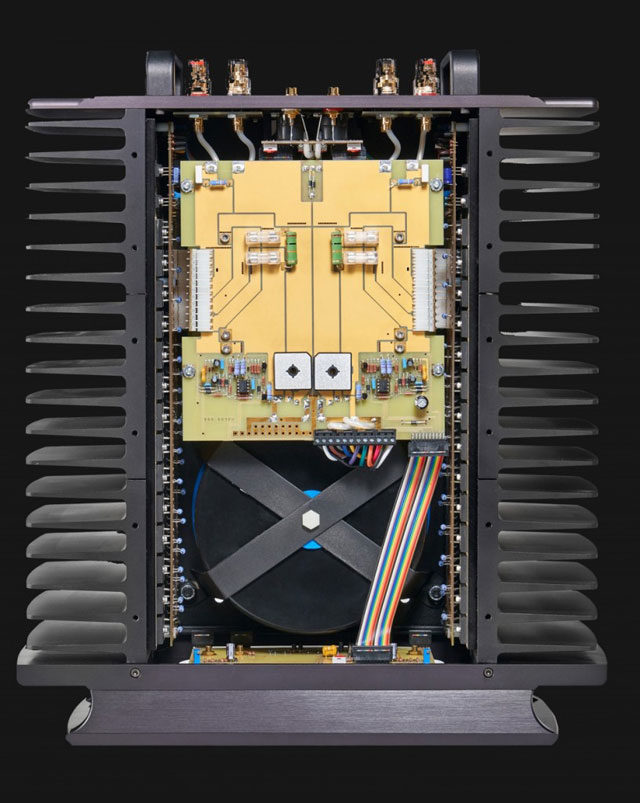
The review 16.0 amplifier sent to me was black and without meters. Its dimensions are 17.5”W, 19”D, and 7.7”H. It weighs 110 pounds. The chassis, which is composed of graphite anodized aluminum and a stainless-steel finish, was fronted by a ½” thick front plate that had an engraved CODA logo in the center. Just below the logo, there are two sets of LEDs/buttons that allowed you to choose between RCA/XLR inputs and to put the amplifier into standby bias. Around back, you find the IEC/main, on/off switch, four pairs of high-quality speaker wire terminals, and a pair of handles. I found the appearance of the 16.0 amplifier to be elegant in an understated fashion. If one wants more “bling,” a couple of cool-looking meters can be added as an upcharge. Internally, you will find first-rate craftsmanship, excellent components such as double-sided gold-plated circuit boards and a very high-quality 3.0kVA toroidal power transformer. The 16.0 amplifier drops 150-watts Class A/B into 8 Ohms and 300 watts Class A/B into 4 Ohms. The first 100 watts into either 8 or 4 Ohms is pure Class-A.
I had purchased the Coda No. 8 amplifier after I reviewed it because it had significantly outperformed, for less money, the other solid-state amplifiers that I used in my large reference system. I was inquisitive to find out what improvements that Coda could bring to their more expensive flagship 16.0 Class-A amplifier over its less expensive but terrific sibling.
Regardless of what speakers, DACs, and preamplifiers I used in my auditioning process to drive my system using the 16.0 amplifier, there were clearly five areas that were improved: not only to the No.8 but with anything in my stable of solid-state/tube amplifiers.
 When I put on jazz trumpeter Jeremy Pelt’s “The Art of Intimacy, Vol. 1,” it was noticeable that the total noise floor of my system was now at an astoundingly lower level than before. The No.8 had been the quietest amplifier I had used compared to other excellent amps in my collection. However, the 16.0 became the new “champ” in this regard. Often, listeners use language for describing a vanishingly-low noise floor using phrases like, “a darker background or, I heard things on familiar music I never had heard before.” My way of expressing what the 16.0 amplifier was rendering at the highest level, was that the smallest micro-details just would float out of the background in an easier to hear fashion and the overall mosaic of the music blended more naturally.
When I put on jazz trumpeter Jeremy Pelt’s “The Art of Intimacy, Vol. 1,” it was noticeable that the total noise floor of my system was now at an astoundingly lower level than before. The No.8 had been the quietest amplifier I had used compared to other excellent amps in my collection. However, the 16.0 became the new “champ” in this regard. Often, listeners use language for describing a vanishingly-low noise floor using phrases like, “a darker background or, I heard things on familiar music I never had heard before.” My way of expressing what the 16.0 amplifier was rendering at the highest level, was that the smallest micro-details just would float out of the background in an easier to hear fashion and the overall mosaic of the music blended more naturally.
 One of my favorite jazz albums is Branford Marsalis’ “Trio Jeepy,” because of the beauty of the music, the powerful individual style that Marsalis plays with on his tenor saxophone, and the sound quality of the colors/timbres of the instruments, overall dynamics/drive, and the acoustics of the studio recording venue are all at the highest level. What shined through with this recording was the 16.0 amplifier’s transient speed and quickness. The 16.0 amplifier nailed every stop/start with precision and an overall effortlessness that made all the pop and pace of the music clearly present. It was if the 16.0 amplifier had the speed of a 211 SET amplifier that could drop 100-watts of Class-A power!
One of my favorite jazz albums is Branford Marsalis’ “Trio Jeepy,” because of the beauty of the music, the powerful individual style that Marsalis plays with on his tenor saxophone, and the sound quality of the colors/timbres of the instruments, overall dynamics/drive, and the acoustics of the studio recording venue are all at the highest level. What shined through with this recording was the 16.0 amplifier’s transient speed and quickness. The 16.0 amplifier nailed every stop/start with precision and an overall effortlessness that made all the pop and pace of the music clearly present. It was if the 16.0 amplifier had the speed of a 211 SET amplifier that could drop 100-watts of Class-A power!
 The album by the talented, but underrated keyboardist Larry Golding, “Whatever It Takes” is a great jazz/funk selection of extremely dynamic B3 Hammond Organ trio music with very extended and powerful bass pedal fundamentals. I use this album to see if an amplifier can produce these low fundamental frequencies with control and accuracy. If you are old enough to remember the JBL speaker commercial ad where the guy’s pants are fluttering because of the sound pressure wave, you have a visual representation not only of the overall macro-dynamics but the bottom-end reproduction of this amplifier. With no effort, the 16.0 amplifier pressurized my huge acoustic space with a visceral response in my gut. I would attribute this ability to create such accurate/precise sub-sonics and grunt to the 16.0 amplifier’s immense power supply and its ability to drop up to 100 Amperes of current per channel on a peak transient.
The album by the talented, but underrated keyboardist Larry Golding, “Whatever It Takes” is a great jazz/funk selection of extremely dynamic B3 Hammond Organ trio music with very extended and powerful bass pedal fundamentals. I use this album to see if an amplifier can produce these low fundamental frequencies with control and accuracy. If you are old enough to remember the JBL speaker commercial ad where the guy’s pants are fluttering because of the sound pressure wave, you have a visual representation not only of the overall macro-dynamics but the bottom-end reproduction of this amplifier. With no effort, the 16.0 amplifier pressurized my huge acoustic space with a visceral response in my gut. I would attribute this ability to create such accurate/precise sub-sonics and grunt to the 16.0 amplifier’s immense power supply and its ability to drop up to 100 Amperes of current per channel on a peak transient.
 One of my favorite pieces of classical music is “Beethoven’s Symphony No. 6 in F Major, Op. 68 (Pastoral).” My finest recording of this magnificent piece of music is on the legendary Mercury Living Presence label. This recording has Antal Dorati conducting the London Symphony Orchestra in England in 1962. If an amplifier is up to the task, along with the rest of the system, two sonic qualities can be experienced. First, you will be transported to the large acoustic space of Watford Town Hall with the illusion of a gigantic realistically layered orchestra in front of you that transcends the boundaries of your listening space. Secondly, the timbre and color of the string section is beautifully captured on this recording. Therefore, the delicacy and sweetness of these string instruments should be easily heard and connected to in an emotional fashion. The 16.0 amplifier brought both these wonderful sonic virtues to a superlative level I had never experienced before in the many years I have listened to this selection of music.
One of my favorite pieces of classical music is “Beethoven’s Symphony No. 6 in F Major, Op. 68 (Pastoral).” My finest recording of this magnificent piece of music is on the legendary Mercury Living Presence label. This recording has Antal Dorati conducting the London Symphony Orchestra in England in 1962. If an amplifier is up to the task, along with the rest of the system, two sonic qualities can be experienced. First, you will be transported to the large acoustic space of Watford Town Hall with the illusion of a gigantic realistically layered orchestra in front of you that transcends the boundaries of your listening space. Secondly, the timbre and color of the string section is beautifully captured on this recording. Therefore, the delicacy and sweetness of these string instruments should be easily heard and connected to in an emotional fashion. The 16.0 amplifier brought both these wonderful sonic virtues to a superlative level I had never experienced before in the many years I have listened to this selection of music.
To answer my own question, would the new flagship Coda 16.0 Class-A amplifier outperform its wonderful, but less-expensive sibling, the No.8? Absolutely. Whatever, Coda discovered/created in their latest generation of equipment, starting with the No.8 amplifier and FET 07x preamplifier, they have brought it to their new flagship 16.0 Class-A amplifier. This amplifier offers boundless macro-dynamics/powerful control of low-end frequencies, gorgeous color/tonality, an overall grainless silky smooth presentation, and the ability to render lifelike spatial dimensions rarely found in solid-state amplifiers. Because of its ability to drop immense current (100 amperes) it will easily drive virtually any speaker on the market today yet retain a beautiful musicality that many “muscle” amplifiers on the market totally miss out on. When you figure in the 16.0 amplifier’s build quality, the quality of its internal components, that’s completely hand-built here in the US, and not inexpensively, but very competitively priced compared to other US-based high-end companies, the 16.0 amplifier is a great addition to the world of audiophile-level equipment. With all I shared in this review I don’t think it’s a surprise I’m figuring out a way to finance my purchase of the 16.0 amplifier because I don’t want it to leave my system.


terry london
Specifications:
Price: $16,000
Class A operation to 100 watts/
300 watts A/B into 4 Ohms
Maximum current: 100 amperes per channel
Power supply: 3KVA power transformer/ Dual independent rectification and 280,000 of power supply filter capacitance
Weight: 110 pounds
Address:
Coda Technologies, Inc.
7850 Cucamonga Avenue
Unit 34
Sacramento, California 95826
USA
Tel: +01 916 383-3653
Fax: +01 916 455-3653
Website: www.coda.com
EMail: info@coda
Associated Equipment
Sources:
Mhdt Lab Orchid DAC
Lab 12 DAC
Threshold DAC 1e
Jay’s Audio MK-II CD transport
CEC MK-II CD transport
Amplification:
Coda FET 07x preamplifier
Coda NO.8 amplifier
Coda 16.0 amplifier
Pass Labs XA-25 amplifier
Triode Labs SET 2A3 amplifier
Threshold 550e amplifier
Linear Tube Audio reference preamplifier
Loudspeakers:
Tekton Design Ulfberth & Perfect Set
NSMT Loudspeaker Model 100
Accessories:
Full loom of Black CAT Coppertone wires
Krolo Design reference rack & footers
Dignity Audio PPT-1500 isolation transformer
Audio Archon power cords
One thought on "Coda Technologies 16.0 Amplifier by Terry London"
Leave a Reply
Stereo Times Masthead
Publisher/Founder
Clement Perry
Editor
Dave Thomas
Senior Editors
Frank Alles, Mike Girardi, Russell Lichter, Terry London, Moreno Mitchell, Paul Szabady, Bill Wells, Mike Wright, and Stephen Yan,
Current Contributors
David Abramson, Tim Barrall, Dave Allison, Ron Cook, Lewis Dardick, John Hoffman, Dan Secula, Don Shaulis, Greg Simmons, Eric Teh, Greg Voth, Richard Willie, Ed Van Winkle, Rob Dockery, Richard Doran, and Daveed Turek
Site Management Clement Perry
Ad Designer: Martin Perry




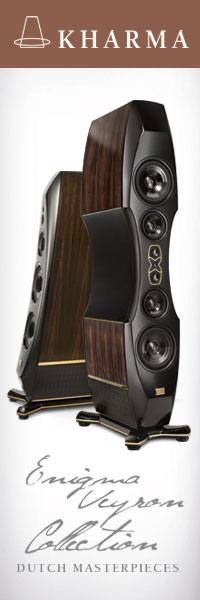
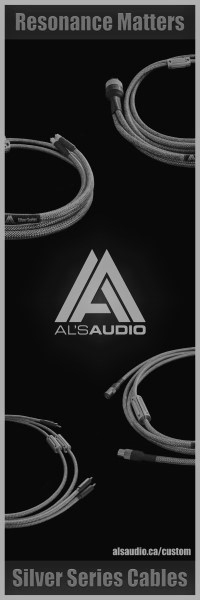

Hello
I purchased it after trying it in house on my Magnepan 20.7, comparing side by side to my Audio Research Ref250 monoblocks fed by an Audio Research Ref3.
I was amazed as the difference was so striking , starting from the firsts seconds playing music, much finesse, much power and grip than my tubed audio research , going deeper in the bass and sweeter in the highs without losing any details or air or space,……also more 3d rendering both in depth and width. Honestly I didn’t expect that at all and was so surprised and delighted during the test that I did buy it and sold my Audio Research.
It says a lot about it !